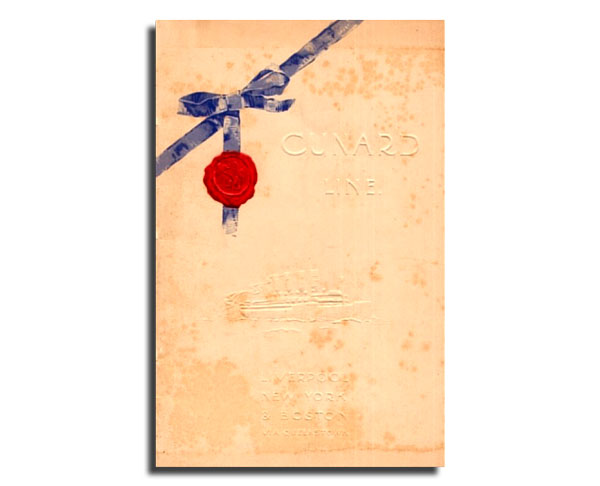Description
Apart from the passenger list the booklet contains details of all Cunard Sailings for August, September and October 1908, with an inserted slip highlighting the Lusitania andMauretania sailings. The times and places where the orchestra of “highly trained musicians” would perform are listed .First and second class mealtimes are given, as are money exchange rates ($4.95 to the pound. Those were the days!) Steamer Chairs could be hired from the Deck Steward for the voyage at 4/- each. Radio telegraph messages could be surprisingly expensive, with a minimum charge of 12/6d for 10 words, extra words 9d each via Cape Race. Address and signature were free.
When introduced in 1905, the Carmania and her running mate, the Caronia, were the largest ships in the Cunard fleet. The Carmania had steam turbines and the Caroniahad quadruple-expansion engines. Another feature that differentiated the two liners was that Carmania had two tall forward deck ventilator cowls while they were absent onCaronia. The Carmania served the Liverpool – New York route from 1905 to 1910 when she had to be temporarily withdrawn having suffered a major fire in June 1910.
Following the outbreak of The Great War, the Carmania was converted into an armed merchant cruiser, equipped with eight 4.7 inch guns and put under the command of Captain Noel Grant. She sailed from Liverpool to the West Indies. She was soon in action, an event that led to her being dubbed “The Ship that Hunted Herself”. The Germans also had AMCs, which altered their appearance to confuse any sighting reports made by neutral steamers. The German AMC, Cap Trafalgar (appropriately named – the ensuing battle owed more to Nelson than to Jellicoe) took down her third funnel – a dummy – sported a couple of large fake ventilators on her foredeck, and with a lick of paint, presented a reasonable facsimile of Carmania at a distance. Thus it was that on 14th September 1914 Carmania found herself confronting her doppelganger which was taking on board coal from colliers which had met her by arrangement at a remote island, Trindade, of the coast of Brazil.
Grant realised that fighting in the vicinity of the island was impossible for two unwieldy liners, so he hauled off, waiting for the Cap Trafalgar to come out. The two engaged with shell fire, inflicting heavy damage on each other, closing to machine gun range. The Cap Trafalgar broke of the action in a sinking condition, her survivors were rescued by the colliers landing them in Argentina, where they were interned. Carmania was in an almost as bad condition, but with the assistance of RN vessels, was able to reach Pernambuco. After repairs in Gibraltar, she patrolled the coast of Portugal and the Atlantic islands until in 1916, she was summoned to assist in the Gallipoli imbroglio. From May 1916, she was used as a troop ship. After the war, she transported Canadian troops back from Europe. Refurbished, she returned to civilian service being refitted in 1923. In 1932, she was sold for scrap.
I wonder what those passengers in 1908 would have thought, if they could have forseen the adventure which would befall their sedate liner in four year’s time!

Reviews
There are no reviews yet.